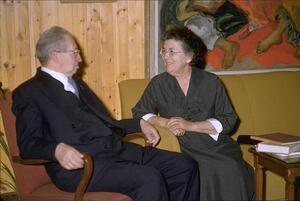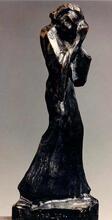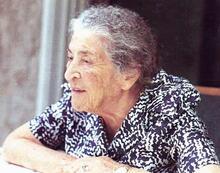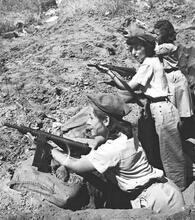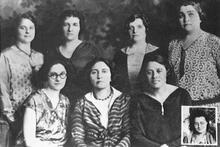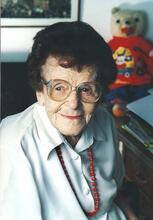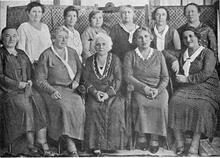Rahel Yanait Ben-Zvi
Rahel and Yitzhak Ben-Zvi at the President's residence in Jerusalem, 1962.
Courtesy of the Israel National Photo Collection via Wikimedia Commons
Long before she became Israel’s First Lady in 1952, Rahel Yanait Ben-Zvi shaped the country by helping create many of its most important organizations. Born Golda Lishansky, she represented her hometown of Malin, Ukraine, at the 1905 Zionist Congress, then helped found the Po’alei Zion socialist party in 1906. She Hebraicized her name to Rahel Yanait when she made Aliyah in 1908. She helped found the Hebrew Gymnasium in Jerusalem and the self-defense group Ha-Shomer. She spent World War I coordinating between Ha-Shomer and Nili, a Jewish spy ring, then helped lead secretive operations against the British, in addition to her active involvement in the labor movement. She wrote ten books and hundreds of articles on the history and evolution of the Yishuv and the State.
In the preface to her book entitled Derakhai Siparti (I Declared My Way, derived from Psalms 119:26: “I have declared my way and you have answered me”), Rahel Yanait Ben-Zvi recalls her life’s work in the spheres of agriculture, the labor movement, the Haganah, and the Jewish community in Palestine prior to the establishment of the State of Israel. "Old Yishuv" refers to the Jewish community prior to 1882; "New Yishuv" to that following 1882.Yishuv. Above all she relates to the formative influence of journeying to and fro in the Land of Israel in different phases of her life—the Second Lit. "ascent." A "calling up" to the Torah during its reading in the synagogue.Aliyah, the period of struggle and the Arab Revolt during the Mandate (1936–1939), the first years of the new state of Israel, her service as the First Lady of Israel’s Presidency and her visits to the ma’abarot (transit camps built for new immigrants). She and her “life partner” Izhak Ben-Zvi (1884–1963) “settled in Jerusalem, embraced its antiquities, and hiked widely across the Judean mountains and desert. We went up to the Galilee, down to the Negev, roaming about for weeks in the desolate expanses, sleeping in the fields and filling our lungs with the air of the homeland … envisioning and dreaming about the future of our nation in the homeland. We prayed in our hearts that we would be entitled to revive it by working and protecting it.” Many years later she recalled the “wonderful feeling that accompanied me when visiting each historical site—the wonderful feeling of being born again in our homeland.” Yanait’s memoirs reflect her perception of The Land of IsraelErez Israel as an empty wasteland awaiting its absent children and pioneers to resettle and rebuild the historical homeland of the Jewish people.
Early Life
Rahel Yanait Ben-Zvi (née Golda Lishansky) was born during the Lit. "weeks." A one-day festival (two days outside Israel) held on the 6th day of the Hebrew month of Sivan (50 days, or 7 complete weeks, from the first day of Passover) to commemorate the Giving of the Torah on Mount Sinai; Pentecost; "Festival of the First Fruits"; "Festival of the Giving of the Torah"; Azeret (solemn assembly).Shavuot festival into a warm Hasidic family in the (Yiddish) Small-town Jewish community in Eastern Europe.shtetl of Malin in the Ukraine (98 km WNW of Kiev). Her parents, Meir Yonah (1862–1942) and Shoshanah (1865–1944) had three additional daughters: Sarah Lishansky, Tamar (1892–1983) and Batia Lichansky. As a girl she experienced both the close-knit lifestyle of the traditional Jewish shtetl and the ever-present fear of the pogroms. She lived in her grandparents’ home, exposed to her grandfather’s sad yearning for Jerusalem and her grandmother’s “ancient legends and Hasidic fables and many stories of Erez Israel.” At the age of fifteen, eager to learn, she moved on her own to Zhitomir to work and study at the Gymnasium. There she developed both her love for botany and her involvement in Zionist youth circles.
Already at the age of nineteen she represented Malin at the Zionist Congress of 1905 held in Basel, Switzerland. In 1906, in Poltava, she was among the founders of the Po’alei Zion socialist party and later became one of its few active women members and leaders in Palestine. The suffering and despair which were the lot of Eastern European Jewry moved her, together with other daring young men and women, to revolt against life in exile.
Making Aliyah
Golda Lishansky immigrated to Palestine in 1908. In her biography she recalls the years that preceded her aliyah and the trigger for her going to Palestine:
One winter morning in 1908… the mailmen brought a letter from Avner [Izhak Ben-Zvi] in Palestine. … It told about the Holiday held on the 14th day of the Hebrew month of Adar (on the 15th day in Jerusalem) to commemorate the deliverance of the Jewish people in the Persian empire from a plot to eradicate them.Purim disturbances at Jaffa. “What, there too? A pogrom there too?” I jumped from my seat. “What am I doing here?” I seemed to hear a clear, ringing voice—“Get up and go to Erez Israel!” (Anu Olim, 1959; Coming Home, 1963).
From the moment she arrived she had a feeling of déjà-vu, that she had been born here and belonged to Erez Israel. Due to her love of Jewish history, and influenced by the heroic Hasmonean period (167–37 b. c. e.), she Hebraicized her name to Rahel Yanait. This symbolic act, deriving from her admiration for King Alexander Yannai (c. 126–76 b. c. e.) who enlarged the boundaries of Israel in the Second Temple era, also honored her father Jonah. Usually she was called Haverah (comrade) Rahel.
She settled in Jerusalem during the period of the Second Aliyah (the second wave of Zionist-oriented immigration to Palestine, 1904–1914), a formative period of the Yishuv (the Jewish community in Palestine). She was one of the first Second Aliyah immigrants who opted to settle in the city, where she became a founder of and teacher at the Hebrew Gymnasium in 1908. In 1909 she participated in the founding meeting of the Jewish self-defense organization Ha-Shomer in Meshah (Kefar Tavor) and was accepted as a member of this prestigious group.
Believing that she had to prepare herself professionally to promote agricultural settlement in Erez Israel, Yanait traveled to France to study agricultural engineering at the University of Nancy (1911–1914). After graduating during World War I she returned to Palestine, where she specialized at Aharon Aaronsohn’s experimental station in Atlit, served in recruiting volunteers to the British army and, so she maintained, coordinating between Ha-Shomer and Nili (a group of Jews in Ottoman-occupied Palestine who worked for British intelligence).
After the war she married her partner Izhak Ben-Zvi and gave birth to two sons who were given biblical names: the elder son Amram (b. 1922) was named after the father of Moses and Aaron; the second son (b. 1924), named after the High Priest Eli, was murdered by Arabs near his A voluntary collective community, mainly agricultural, in which there is no private wealth and which is responsible for all the needs of its members and their families.kibbutz in the Galilee in 1948. Rahel Yanait maintained very close ties with her sisters and parents, who shared a home with the Ben-Zvis after they immigrated to Palestine and took care of the Ben-Zvis’ children.
Political Activities and Stances
In her writings she related little to personal matters or to her roles as wife and mother. She barely mentioned the contradiction between women’s obligations in the public and the private spheres. Yanait was not a professed feminist. Looking back she stressed that she never had a special interest in “suffragism.” She believed that talented women could rise to outstanding achievements and that they should demand equal work opportunity, equal remuneration, and the opportunity to learn a profession or vocation, but not through a suffragist movement. The fact that on repeated occasions since her youth in the shtetl she was the first and only woman in many frameworks seemed natural to her and not a source of pride. One example of her attitude in the matter of gender and equality of women in Israel was her total support in the 1950s of recruiting women to the Israel Defense Forces: “Our position, mine and that of Ben-Zvi, persisting from the times of Ha-Shomer and the Haganah, was that it is essential to include the girls, and even to expand their roles in the army. This was our shared position since the beginning of our way in the Labor Movement” (Kark, Interviews).
Yanait was among the founders and molders of the early Labor Movement in Palestine/Israel, its socialist ideology, method and institutions. She was a member of Po’alei Zion, the Ahdut Ha’avodah Party, and the General Histadrut (Federation of Labor in Erez Israel). In 1925–1927 she inspired the establishment of the Zionist Pioneer Women of America and Canada, a sister organization to the Council of Women Workers in Palestine, and organized the Women’s League for Palestine in the United States to build houses for pioneer women in Palestine. She became a central active member of the Haganah (a voluntary Jewish self-defense organization that operated against Arab attacks during the Mandate for Palestine given to Great Britain by the League of Nations in April 1920 to administer Palestine and establish a national home for the Jewish people. It was terminated with the establishment of the State of Israel on May 14, 1948.British Mandate and was the precursor of the Israel Defense Forces). As one of the heads of the Haganah in Jerusalem, she was involved in the infamous assassination in 1924 of Jacob Israel de Haan (1881–1924), who opposed the Zionist Movement (Kark, Interviews). Active in women’s organizations, she participated in Mo’ezet Ha-Po’alot (The Council of Women Workers). In 1920 she opened a tree nursery in Jerusalem which evolved into a women’s collective. At the Third Women Workers’ Convention in 1926 Rahel Yanait read a letter from “Oriental comrades” (Lit. "Eastern." Jew from Arab or Muslim country.Mizrahim) complaining about the lack of Histadrut activity among their ranks. In 1928 she received the support of the Convention to establish the Working Women’s Farm (Meshek ha-Po’alot), a training facility in Talpiot, south Jerusalem. Due to the need for the absorption of refugees from Nazi Germany in 1933, this was transformed into Havat ha-Limmud le-Ne’arot (training farm for girls) and subsequently admission was permitted also for boys. After the 1948 War of Independence she established the Agricultural Youth Village for immigrants in the abandoned Arab village of Ein Kerem near Jerusalem.
Public Service as First Lady and After
When her husband began his tenure as the second president of the State of Israel (1952–1963) she took an active role as First Lady. She is credited for the design of the President’s House and ensuring its unique character, with its easy accessibility and special status among the new immigrants of multiple ethnic groups who had recently immigrated to Israel from many diasporas. After the death of Izhak she initiated the establishment of Yad Ben-Zvi, an institution dedicated to research and publication of studies on the history of Erez Israel and on the ethnic heritage of the Sephardi and Eastern Jews, as well as to bringing the fruits of scholarship to the people via seminars, conferences, and field trips. In the 1960s and 1970s Yanait dedicated her efforts to renewal of the ancient Jewish settlement at Peki’in in the Galilee and promotion of the ideology of Erez Israel ha-Shlemah (The Greater Land of Israel Movement). In recognition of her contribution to the country and its society she was awarded the Henrietta Szold Prize in 1958, honorary citizenship of Jerusalem in 1965, and the most prestigious award in Israel, the Israel Prize for lifetime achievement, in 1978.
Rahel Yanait Ben-Zvi was a central figure and one of the leading women activists of the Jewish Yishuv in Palestine and in the State of Israel. She was a prolific writer, who authored ten books, participated in the editing of six more, and published over 500 articles and notes. Her personal biography parallels and reflects a critical period in the modern history of the Jewish people—“an account of the fateful change in Jewish history with which her life was intertwined—the pioneering effort which led to the state of Israel” (Coming Home). Her life story is one of the shaping of ideology and realization of the New Yishuv, its character and its accomplishments. In addition, it reflects the perception, status and contribution of Jewish women in Palestine/Israel, balancing the androcentric Israeli pioneering ethos.
Selected Works
Yanait, Rahel and Izhak Ben-Zvi. Eli (Hebrew). Jerusalem: 1957.
Yanait Ben-Zvi, Rahel. Anu Olim: Pirke Hayim (We Ascend). Tel Abib: Am ‘oved, 1959.
Yanait Ben-Zvi, Rahel. Coming Home. Translated from the Hebrew by David Harris and Julian Meltzer. Tel Aviv: Massadah, 1963.
Yanait Ben-Zvi, Rahel. Derakhai Siparti (I Told My Way). Jerusalem: Kiryat-Sefer, 1971.
Kark, Ruth. “Interviews with Rahel Yanait Ben-Zvi.” 1977–1979.
Michaeli, Ben-Zion. Ha-Geveret ha-rishonah (The First Lady). Tel Aviv: Milo, 1992.
Rubinstein, Shimon, editor. Rahel Yanait Ben-Zvi: Written Words (Hebrew). Jerusalem: Yad Izhak Ben-Zvi, 1978.
Shilo, Margalit. “Rahel Yanit Ben-Zvi” (Hebrew). In Sefer Aliyah II, edited by Z. Zahor. Jerusalem: 1997.
Shilo, Margalit, Ruth Kark and Galit Hasan-Rokem, editors. ha-‘Ivriyot ha-hadashot: nashim ba-yishuv uva Tsiyonut bi-rei ha-migdar (Jewish Women in the Yishuv and Zionism: A Gender Perspective). Jerusalem: Yad Izhak Ben-Zvi, 2001.

